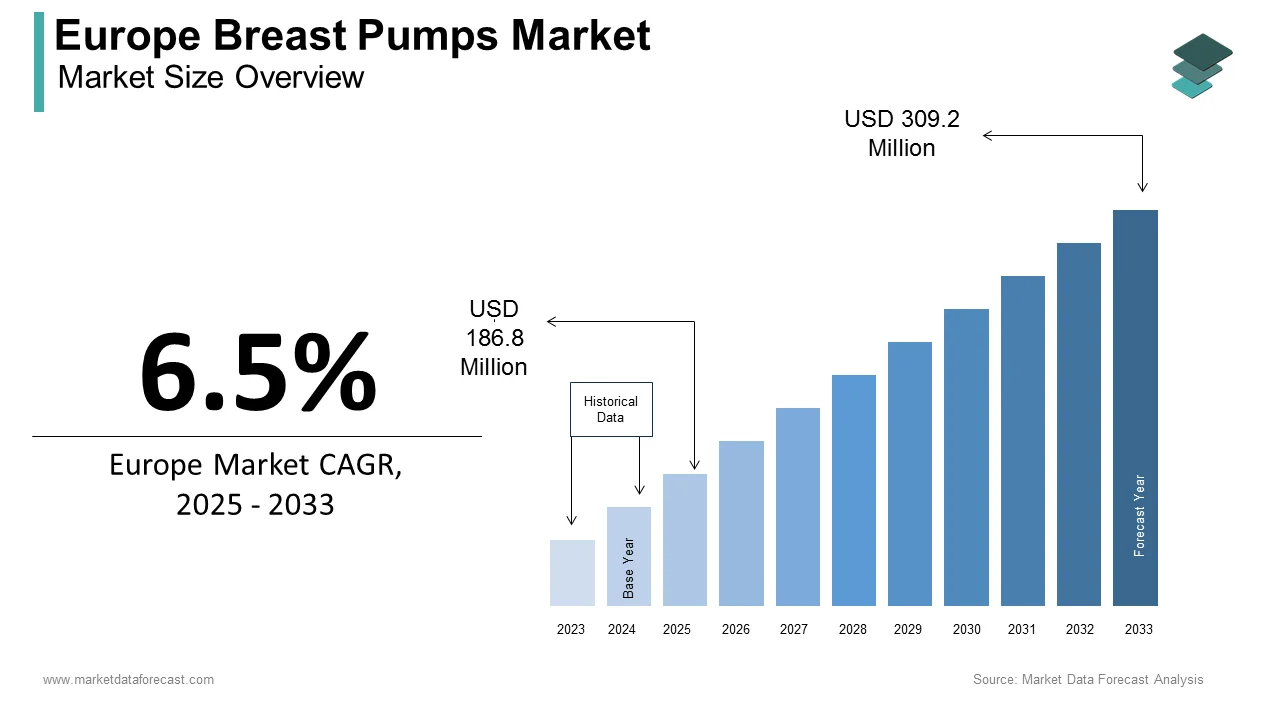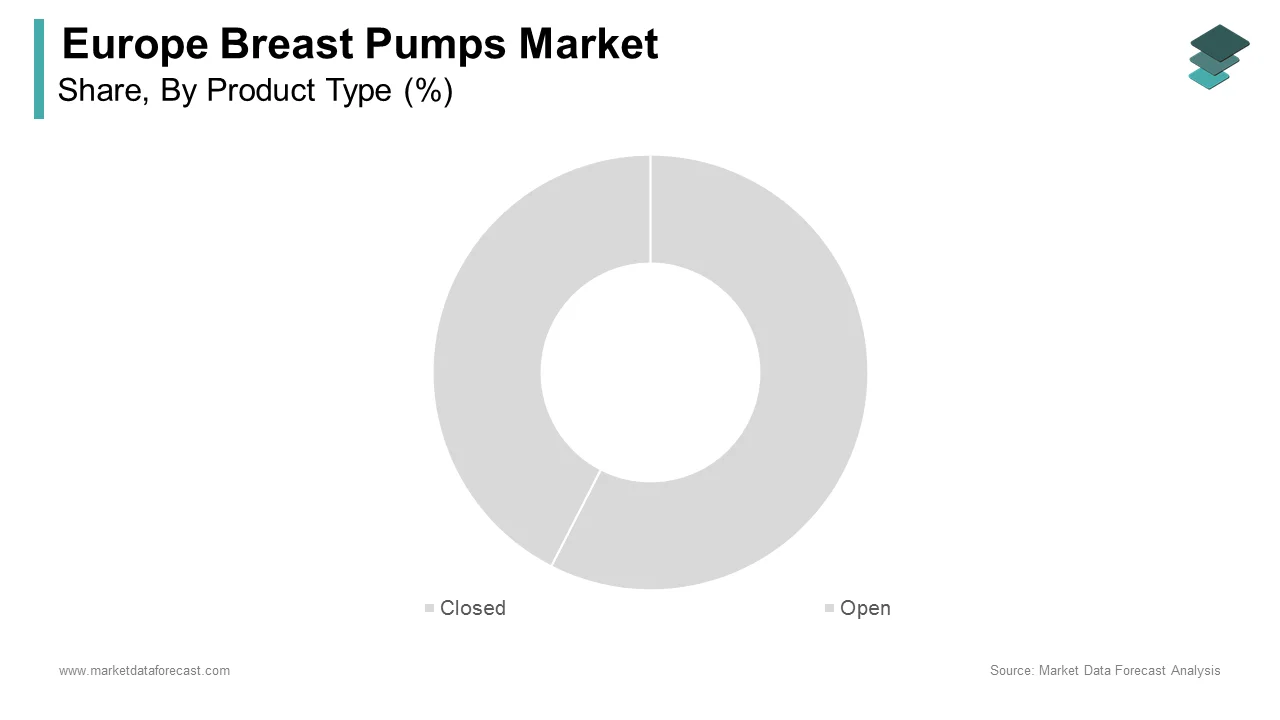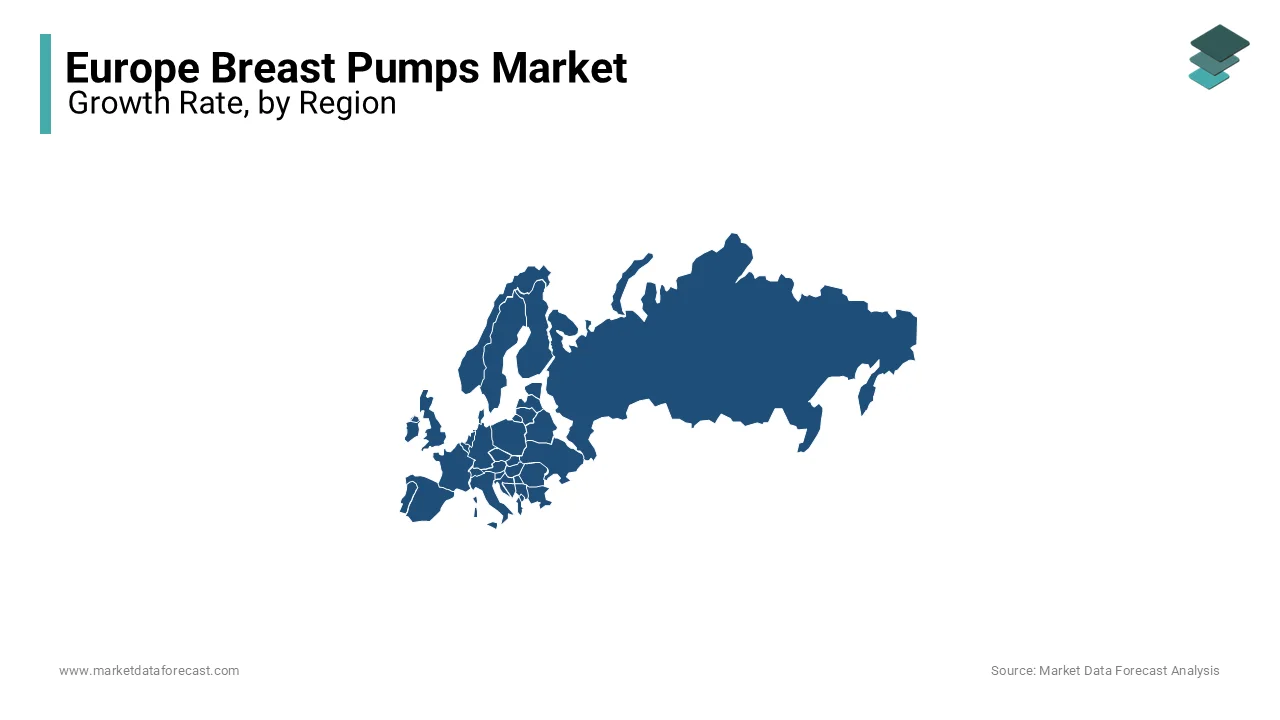Europe Breast Pumps Market Size, Share, Trends & Growth Forecast Report By Product Type, Application, Technology and Country (The UK, France, Spain, Germany, Italy, Russia, Sweden, Denmark, Switzerland, Netherlands, Turkey, Czech Republic and Rest of Europe), Industry Analysis From 2025 To 2033
Europe Breast Pumps Market Size
The size of the breast pumps market in Europe was valued at USD 175.4 million in 2024. The European market size is estimated to be worth USD 309.2 million by 2033 from USD 186.8 million in 2025, growing at a CAGR of 6.5% from 2025 to 2033.

Breast pumps play a critical role in supporting maternal and infant health due to the increasing awareness about breastfeeding benefits and the rising participation of women in the workforce. Breast pumps are medical devices designed to extract breast milk by providing convenience for lactating mothers and ensuring the availability of breast milk even in their absence.
The European market has witnessed significant growth due to improved healthcare infrastructure and initiatives promoting breastfeeding. According to the World Health Organization, exclusive breastfeeding for the first six months is recommended to ensure optimal infant health by emphasizing the need for breastfeeding support technologies. Countries like Germany, the United Kingdom, and France lead in market adoption due to high disposable incomes and robust healthcare systems. According to a 2022 report from UNICEF Europe, around 30% of working mothers in Europe rely on breast pumps to continue breastfeeding while meeting workplace demands. Additionally, technological advancements, such as double-electric and wearable breast pumps, have enhanced user convenience.
MARKET DRIVERS
Increasing Workforce Participation of Women in Europe
The rising participation of women in the workforce is a key driver of the Europe breast pumps market. According to Eurostat, the employment rate for women in the European Union reached 67% in 2022, with many countries implementing supportive workplace policies for working mothers. Breast pumps provide a practical solution for employed women to continue breastfeeding while managing their professional responsibilities. The International Labour Organization highlights that parental leave policies and workplace lactation support programs have amplified the demand for breast pumps. This trend is especially pronounced in countries like Germany and France, where female employment and awareness of breastfeeding benefits are both high, contributing to the market's expansion.
Growing Awareness of Breastfeeding Benefits
Increasing awareness of the health benefits associated with breastfeeding has significantly boosted the demand for breast pumps. The World Health Organization emphasizes that exclusive breastfeeding during the first six months can prevent malnutrition and reduce infant mortality. In Europe, national healthcare campaigns, such as the UK’s Start4Life initiative, have played a pivotal role in promoting breastfeeding practices. A 2021 UNICEF Europe report revealed that breastfeeding rates have been steadily improving, with approximately 40% of mothers initiating breastfeeding shortly after birth. This awareness, coupled with the need for efficient milk expression solutions, has driven the adoption of advanced breast pump technologies across the region.
MARKET RESTRAINTS
High Cost of Breast Pump Devices
The high cost of breast pumps remains a significant restraint in the Europe breast pumps market, limiting their accessibility for a portion of the population. Advanced models, such as double-electric and wearable breast pumps, can cost upwards of €300, making them unaffordable for low-income families. According to Eurostat, approximately 17% of the EU population was at risk of poverty or social exclusion in 2022, underscoring the economic disparities that impact healthcare product affordability. Additionally, reimbursement policies for breast pumps vary widely across European countries, with limited coverage in several regions. This lack of uniform financial support discourages adoption, particularly in economically constrained households.
Limited Awareness in Underdeveloped Regions
Despite increasing awareness in developed parts of Europe, many underdeveloped or rural areas lag in understanding the benefits of breast pumps. The European Commission’s 2022 health report indicated disparities in maternal health education between urban and rural populations, with rural women having lower breastfeeding rates and limited access to lactation support resources. In countries like Romania and Bulgaria, where healthcare infrastructure is less developed, the adoption of breast pumps remains low. This gap in awareness and accessibility restricts market growth, as many mothers in these regions continue to rely on traditional breastfeeding methods without the support of modern medical devices.
MARKET OPPORTUNITIES
Expansion of Workplace Breastfeeding Support Programs
The growing implementation of workplace breastfeeding support programs presents a significant opportunity for the Europe breast pumps market. According to the European Commission, many countries are strengthening parental leave policies and encouraging employers to provide breastfeeding-friendly environments. For instance, the EU Directive on Work-Life Balance mandates workplace accommodations for nursing mothers, including private spaces for milk expression. These initiatives enhance the accessibility and convenience of breast pumps for working mothers. A Eurostat report from 2022 shows that over 67% of women in the EU workforce benefit from workplace support, fostering an environment where breast pump adoption can thrive, particularly among career-focused mothers balancing professional and maternal responsibilities.
Advancements in Breast Pump Technology
Technological advancements in breast pump design and functionality offer significant growth opportunities for the Europe breast pumps market. Innovations such as lightweight wearable pumps, app-connected devices, and noise-reduction technology have enhanced user convenience and efficiency. The European Patent Office noted a 15% increase in patents related to breast pump technologies between 2020 and 2022, reflecting a surge in innovation. Additionally, countries like Germany and the UK are witnessing increased adoption of these advanced models due to their high disposable income levels and preference for premium healthcare products. These advancements address user pain points and improve the overall breastfeeding experience, driving market demand across diverse consumer segments.
MARKET CHALLENGES
Inconsistent Reimbursement Policies Across Europe
The lack of uniform reimbursement policies for breast pumps across European countries poses a significant challenge to market growth. While countries like France and Germany offer partial reimbursement for medical-grade breast pumps, others, such as the UK, have limited or no financial support for these devices. According to a 2022 European Commission health report, these inconsistencies create disparities in accessibility, particularly for lower-income families. This fragmented approach not only limits adoption in underserved regions but also complicates market entry for manufacturers aiming to cater to broader demographics, ultimately hindering the market’s growth potential across Europe.
Stigma and Social Barriers Around Breastfeeding
Cultural stigma and social barriers related to breastfeeding and breast pump usage remain a challenge in the Europe breast pumps market. Despite increasing awareness, a 2021 UNICEF Europe report found that 20% of mothers in rural and traditional communities faced discomfort or societal disapproval when using breast pumps or breastfeeding in public. This stigma can discourage mothers from adopting breast pumps, particularly in conservative regions of countries like Italy and Poland. Additionally, limited education about the benefits of breastfeeding and breast pump technology perpetuates misconceptions, reducing market penetration in areas where cultural norms discourage open discussion of maternal health practices.
REPORT COVERAGE
|
REPORT METRIC |
DETAILS |
|
Market Size Available |
2024 to 2033 |
|
Base Year |
2024 |
|
Forecast Period |
2025 to 2033 |
|
Segments Covered |
By Product Type, Application, Technology, and country. |
|
Various Analysis Covered |
Global, Regional & Country Level Analysis, Segment-Level Analysis; DROC, PESTLE Analysis, Porter's Five Forces Analysis, Competitive Landscape, Analyst Overview of Investment Opportunities |
|
Countries Covered |
UK, France, Spain, Germany, Italy, Russia, Sweden, Denmark, Switzerland, Netherlands, Turkey, Czech Republic, and Rest of Europe. |
|
Market Leader Profiled |
Pigeon Group (Pigeon Corporation), Koninklijke Philips N.V., Ameda, Inc., Ardo Medical Ag, and Evenflo Feeding, Inc. Other players in the market are Mayborn Group Limited (Shanghai Jahwa Co. Ltd), Spectra Baby USA, Albert Manufacturing USA (Albert Group) and Hygeia Health., and Others. |
SEGMENT ANALYSIS
By Product Type

REGIONAL ANALYSIS
Germany was the top performer in the European breast pump market in 2024. This can be attributed to the robust healthcare infrastructure and supportive maternity policies in Germany. As per the Federal Statistical Office of Germany, more than 65% of German mothers initiate breastfeeding within the first hour of childbirth, fostering demand for breastfeeding support devices. Moreover, Germany’s parental leave policy, which offers up to 14 months of paid leave, allows mothers to prioritize breastfeeding. Advanced breast pump adoption is further driven by high disposable incomes and insurance coverage for medical-grade devices. These factors, coupled with an increasing number of working mothers, solidify Germany’s position as a top market for breast pump manufacturers.

France is another leading country in the European breast pumps market and is estimated to account for a notable share of the European market over the forecast period due to its comprehensive maternity benefits and high breastfeeding rates. The French Ministry of Health reports that 63% of mothers exclusively breastfeed during the initial months, creating sustained demand for breast pumps. France’s robust social security system covers part of the cost for breast pumps prescribed by healthcare providers, increasing accessibility. Additionally, government-led breastfeeding awareness campaigns, such as “Breastfeeding Week,” emphasize the importance of continued breastfeeding, even for working mothers. These initiatives, alongside a strong healthcare network, make France one of the leading contributors to the European breast pumps market.
The United Kingdom is a significant market for breast pumps in Europe and is predicted to exhibit a healthy CAGR over the forecast period. The growth of the UK market is driven by increasing awareness and government efforts to promote breastfeeding. According to Public Health England, 48% of mothers continue to breastfeed at six months, a rate supported by initiatives like the Baby Friendly Initiative by UNICEF UK. The growing number of working mothers, with a 74% female employment rate as reported by the Office for National Statistics in 2022, has spurred demand for breast pumps. Additionally, the UK’s advanced retail networks and e-commerce platforms provide widespread access to both manual and electric breast pumps, reinforcing its strong market position.
KEY MARKET PLAYERS
Companies playing a prominent role in the European Breast pump market profiled in this report are Pigeon Group (Pigeon Corporation), Koninklijke Philips N.V., Ameda, Inc., Ardo Medical Ag, and Evenflo Feeding, Inc. Other players in the market are Mayborn Group Limited (Shanghai Jahwa Co. Ltd), Spectra Baby USA, Albert Manufacturing USA (Albert Group) and Hygeia Health.
MARKET SEGMENTATION
This research report on the European breast pumps market is segmented and sub-segmented into the following categories.
By Product Type
- Closed
- Open
By Application
- Personal Use Pumps
- Healthcare/hospital Grade Pumps
By Technology
- Battery Powered
- Manual
- Electric
By Country
- UK
- France
- Spain
- Germany
- Italy
- Russia
- Sweden
- Denmark
- Switzerland
- Netherlands
- Turkey
- Czech Republic
- Rest of Europe
Related Reports
Access the study in MULTIPLE FORMATS
Purchase options starting from $ 2000
Didn’t find what you’re looking for?
TALK TO OUR ANALYST TEAM
Need something within your budget?
NO WORRIES! WE GOT YOU COVERED!
Call us on: +1 888 702 9696 (U.S Toll Free)
Write to us: [email protected]
